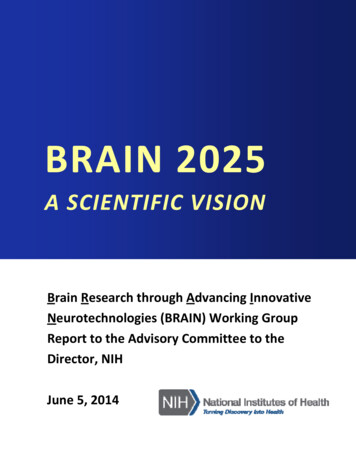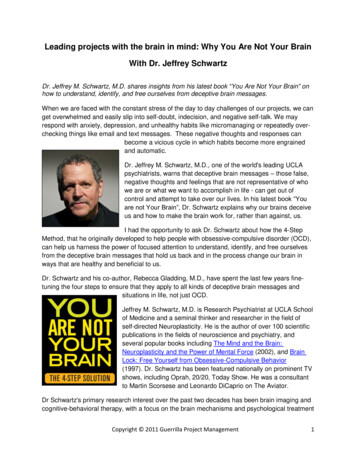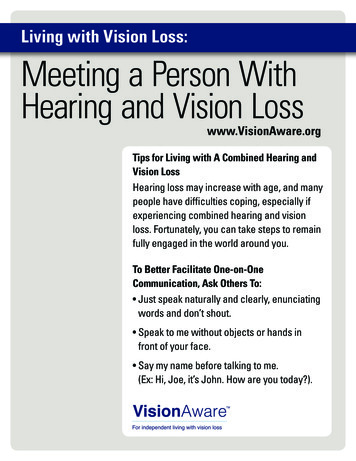
Transcription
97BRAIN 2025A SCIENTIFIC VISIONBrain Research through Advancing InnovativeNeurotechnologies (BRAIN) Working GroupReport to the Advisory Committee to theDirector, NIHJune 5, 2014
ROSTERCornelia Bargmann, PhD (co‐chair)The Rockefeller UniversityEve Marder, PhDBrandeis UniversityWilliam Newsome, PhD (co‐chair)Stanford UniversityRichard Normann, PhDUniversity of UtahDavid Anderson, PhDCalifornia Institute of TechnologyJoshua Sanes, PhDHarvard UniversityEmery Brown, MD, PhDMassachusetts Institute of Technologyand Massachusetts General HospitalMark Schnitzer, PhDStanford UniversityKarl Deisseroth, MD, PhDStanford UniversityJohn Donoghue, PhDBrown UniversityPeter MacLeish, PhDMorehouse School of MedicineTerrence Sejnowski, PhDSalk Institute for Biological StudiesDavid Tank, PhDPrinceton UniversityRoger Tsien, PhDUniversity of California, San DiegoKamil Ugurbil, PhDUniversity of MinnesotaEX OFFICIO MEMBERSKathy Hudson, PhDNational Institutes of HealthJohn Wingfield, PhDNational Science FoundationGeoffrey Ling, MD, PhDDefense Advanced Research ProjectsAgencyCarlos Peña, PhDFood and Drug AdministrationEXECUTIVE SECRETARYLyric Jorgenson, PhDNational Institutes of Health2
TABLE OF CONTENTSEXECUTIVE SUMMARY . . 5PREAMBLE . 9SECTION I. THE BRAIN INITIATIVE: VISION AND PHILOSOPHY . 11The Goal of the BRAIN Initiative . 12Foundational Concepts: Neural Coding, Neural Circuit Dynamics,and Neuromodulation . 13Why Now? . 14The Brain and Behavior . 15Strategies and Experimental Systems . 16The Roads Not Taken . 16Studying the Healthy Brain Should Accelerate Understanding of BrainDisorders . 17The Deliverables of the BRAIN Initiative . 18SECTION II. SCIENTIFIC REVIEW AND HIGH PRIORITY RESEARCH AREAS . 201. Mapping the Structure and Components of Circuits . 202. Neuronal Dynamics: Recording Neuronal Activity Across Time andSpace .263. Manipulating Circuit Activity . 344. The Importance of Behavior . 355. Theory, Modeling, and Statistics Will Be Essential to Understandingthe Brain . 366. Human Neuroscience and Neurotechnology . 407. Education . 488. Maximizing the Value of the BRAIN Initiative: Core Principles .499. Further Reading . . . . . . 563
SECTION III. IMPLEMENTATION: GOALS, DELIVERABLES, TIMELINES, AND COSTS .591. Discovering Diversity . 602. Maps at Multiple Scales . 663. The Brain in Action . 744. Demonstrating Causality . 835. Identifying Fundamental Principles . 896. Advancing Human Neuroscience . 1007. From BRAIN Initiative to the Brain . 1078. Supporting the Core Principles of the BRAIN Initiative . 1119. Cost Estimates . . 12110. Concluding Remarks . 12411. References . 127APPENDIX A – HOW THE BRAIN INITIATIVE WILL ADVANCE CLINICAL RESEARCH .136APPENDIX B – EXPERT CONSULTATIONS . . . . . 142APPENDIX C – ACRONYM LIST . 1454
EXECUTIVE SUMMARYThe human brain is the source of our thoughts, emotions, perceptions, actions, and memories;it confers on us the abilities that make us human, while simultaneously making each of usunique. Over recent years, neuroscience has advanced to the level that we can envision acomprehensive understanding of the brain in action, spanning molecules, cells, circuits,systems, and behavior. This vision, in turn, inspired the BRAIN Initiative. On April 2, 2013,President Obama launched the BRAIN Initiative to “accelerate the development and applicationof new technologies that will enable researchers to produce dynamic pictures of the brain thatshow how individual brain cells and complex neural circuits interact at the speed of thought.”In response to this Grand Challenge, the National Institutes of Health (NIH) convened a workinggroup of the Advisory Committee to the Director, NIH, to develop a rigorous plan for achievingthis scientific vision. This report presents the findings and recommendations of the workinggroup, including the scientific background and rationale for the BRAIN Initiative as a whole andfor each of seven major goals articulated in the report. In addition, we include specificdeliverables, timelines, and cost estimates for these goals as requested by the NIH Director.The charge from the President and from the NIH Director is bold and ambitious. The workinggroup agreed that the best way to set this vision in motion is to accelerate technologydevelopment, as reflected in the name of the BRAIN Initiative: “Brain Research throughAdvancing Innovative Neurotechnologies.” The focus is not on technology per se, but on thedevelopment and use of tools for acquiring fundamental insight about how the nervous systemfunctions in health and disease. The initiative is only one part of the NIH’s investment in basic,translational, and clinical neuroscience, but neurotechnology should advance other areas aswell. To achieve these goals, we recommend that the BRAIN Initiative develop over a ten‐yearperiod beginning in FY2016, with a primary focus on technology development in the first fiveyears, shifting in the second five years to a primary focus on integrating technologies to makefundamental new discoveries about the brain. The distinction between these phases is notblack and white, but rather is a matter of emphasis and opportunity. Discovery‐based sciencewill motivate technology development in the first phase, and further technology developmentwill be needed as the focus shifts to discovery in later years.In considering these goals and the current state of neuroscience, the working group identifiedthe analysis of circuits of interacting neurons as being particularly rich in opportunity, withpotential for revolutionary advances. Truly understanding a circuit requires identifying andcharacterizing the component cells, defining their synaptic connections with one another,observing their dynamic patterns of activity as the circuit functions in vivo during behavior, andperturbing these patterns to test their significance. It also requires an understanding of thealgorithms that govern information processing within a circuit and between interacting circuitsin the brain as a whole. The analysis of circuits is not the only area of neuroscience worthy ofattention, but advances in technology are driving a qualitative shift in what is possible, andfocused progress in this area will benefit many other areas of neuroscience.5
With these considerations in mind, the working group consulted extensively with the scientificcommunity to evaluate challenges and opportunities in the field. The following areas wereidentified as high priorities for the BRAIN Initiative. These goals are intellectually and practicallyexpanded in Sections II and III of this report.#1. Discovering diversity: Identify and provide experimental access to the different brain celltypes to determine their roles in health and disease. It is within reach to characterize all celltypes in the nervous system, and to develop tools to record, mark, and manipulate theseprecisely defined neurons in the living brain. We envision an integrated, systematic census ofneuronal and glial cell types, and new genetic and non‐genetic tools to deliver genes, proteins,and chemicals to cells of interest in non‐human animals and in humans.#2. Maps at multiple scales: Generate circuit diagrams that vary in resolution from synapsesto the whole brain. It is increasingly possible to map connected neurons in local circuits anddistributed brain systems, enabling an understanding of the relationship between neuronalstructure and function. We envision improved technologies—faster, less expensive, scalable—for anatomic reconstruction of neural circuits at all scales, from non‐invasive whole humanbrain imaging to dense reconstruction of synaptic inputs and outputs at the subcellular level.#3. The brain in action: Produce a dynamic picture of the functioning brain by developing andapplying improved methods for large‐scale monitoring of neural activity. We should seize thechallenge of recording dynamic neuronal activity from complete neural networks, over longperiods, in all areas of the brain. There are promising opportunities both for improving existingtechnologies and for developing entirely new technologies for neuronal recording, includingmethods based on electrodes, optics, molecular genetics, and nanoscience, and encompassingdifferent facets of brain activity.#4. Demonstrating causality: Link brain activity to behavior with precise interventional toolsthat change neural circuit dynamics. By directly activating and inhibiting populations ofneurons, neuroscience is progressing from observation to causation, and much more ispossible. To enable the immense potential of circuit manipulation, a new generation of toolsfor optogenetics, chemogenetics, and biochemical and electromagnetic modulation should bedeveloped for use in animals and eventually in human patients.#5. Identifying fundamental principles: Produce conceptual foundations for understandingthe biological basis of mental processes through development of new theoretical and dataanalysis tools. Rigorous theory, modeling, and statistics are advancing our understanding ofcomplex, nonlinear brain functions where human intuition fails. New kinds of data are accruingat increasing rates, mandating new methods of data analysis and interpretation. To enableprogress in theory and data analysis, we must foster collaborations between experimentalistsand scientists from statistics, physics, mathematics, engineering, and computer science.#6. Advancing human neuroscience: Develop innovative technologies to understand thehuman brain and treat its disorders; create and support integrated human brain researchnetworks. Consenting humans who are undergoing diagnostic brain monitoring, or receiving6
neurotechnology for clinical applications, provide an extraordinary opportunity for scientificresearch. This setting enables research on human brain function, the mechanisms of humanbrain disorders, the effect of therapy, and the value of diagnostics. Meeting this opportunityrequires closely integrated research teams performing according to the highest ethicalstandards of clinical care and research. New mechanisms are needed to maximize thecollection of this priceless information and ensure that it benefits people with brain disorders.#7. From BRAIN Initiative to the brain: Integrate new technological and conceptualapproaches produced in Goals #1‐6 to discover how dynamic patterns of neural activity aretransformed into cognition, emotion, perception, and action in health and disease. The mostimportant outcome of the BRAIN Initiative will be a comprehensive, mechanistic understandingof mental function that emerges from synergistic application of the new technologies andconceptual structures developed under the BRAIN Initiative.The overarching vision of the BRAIN Initiative is best captured by Goal #7—combining theseapproaches into a single, integrated science of cells, circuits, brain, and behavior. For example,immense value is added if recordings are conducted from identified cell types whoseanatomical connections are established in the same study. Such an experiment is currently anexceptional tour de force; with new technology, it could become routine. In another example,neuronal populations recorded during complex behavior might be immediately retested withcircuit manipulation techniques to determine their causal role in generating the behavior.Theory and modeling should be woven into successive stages of ongoing experiments, enablingbridges to be built from single cells to connectivity, population dynamics, and behavior.This synthetic approach will enable penetrating solutions to longstanding problems in brainfunction, but we also emphasize the likelihood of entirely new, unexpected discoveries that willresult from the new technologies. In some sense, BRAIN Initiative scientists who apply the newactivity‐monitoring technology will be like Galileo looking into the heavens with the first opticaltelescope. Similarly, new perturbation tools and quantitative approaches are likely to yieldextraordinary insights into the relationship between brain activity and mental functions. Weexpect to discover new forms of neural coding as exciting as the discovery of place cells, andnew forms of neural dynamics that underlie neural computations.Over the course of our deliberations, specific themes emerged that should become coreprinciples for the NIH BRAIN Initiative.1. Pursue human studies and non‐human models in parallel. The goal is to understand thehuman brain, but many methods and ideas will be developed first in animal models.Experiments should take advantage of the unique strengths of diverse species andexperimental systems.2. Cross boundaries in interdisciplinary collaborations. No single researcher or discoverywill solve the brain’s mysteries. The most exciting approaches will bridge fields, linkingexperiment to theory, biology to engineering, tool development to experimentalapplication, human neuroscience to non‐human models, and more, in innovative ways.7
3. Integrate spatial and temporal scales. A unified view of the brain will cross spatial andtemporal levels, recognizing that the nervous system consists of interacting molecules,cells, and circuits across the entire body, and important functions can occur inmilliseconds or minutes, or take a lifetime.4. Establish platforms for sharing data. Public, integrated repositories for datasets anddata analysis tools, with an emphasis on ready accessibility and effective centralmaintenance, will have immense value.5. Validate and disseminate technology. New methods should be critically tested throughiterative interaction between tool‐makers and experimentalists. After validation,mechanisms must be developed to make new tools available to all.6. Consider ethical implications of neuroscience research. BRAIN Initiative research mayraise important issues about neural enhancement, data privacy, and appropriate use ofbrain data in law, education and business. These important issues must be consideredin a serious and sustained manner. BRAIN Initiative research should hew to the highestethical standards for research with human subjects and with non‐human animals underapplicable federal and local laws.7. Accountability to NIH, the taxpayer, and the basic, translational, and clinicalneuroscience communities. The BRAIN Initiative is extremely broad in interdisciplinaryscope and will involve multiple partners both within and outside the NIH. Oversightmechanisms should be established to ensure that BRAIN funds are invested wisely forthe ultimate benefit of the public and the scientific community.To guide the BRAIN Initiative and ensure that these goals and principles are evaluated andrefreshed as appropriate, we recommend that a scientific advisory board be established, to becomposed of scientists who are experts in the diverse fields relevant to the Initiative –neuroscience, molecular biology, the clinical sciences, the physical and quantitative sciences,and ethics. The rapid pace of technological and conceptual change in neuroscience almostensures that some portions of this report will be obsolete within several years. A cohesive andrigorous scientific advisory board will be invaluable in responding to future challenges.As part of the planning process, the working group was asked to estimate the cost of the BRAINInitiative. While we did not conduct a detailed cost analysis, we considered the scope of thequestions to be addressed by the initiative, and the cost of programs that have developed inrelated areas over recent years. Thus our budget estimates, while provisional, are informed bythe costs of real neuroscience at this technological level. To vigorously advance the goals of theBRAIN Initiative as stated above, we recommend an investment by the NIH that ramps up to 400 million/year over the next five years (FY16‐20), and continues at 500 million/yearsubsequently (FY21‐25). A sustained, decade‐long commitment at this level will attracttalented scientists from multiple fields to the interdisciplinary collaborations that are essentialto the BRAIN Initiative and its ambitious goals.8
PREAMBLEWe stand on the verge of a great journey into the unknown—the interior terrain of thinking,feeling, perceiving, learning, deciding, and acting to achieve our goals—that is the specialprovince of the human brain. These capacities are the essence of our minds and the aspects ofbeing human that matter most to us. Remarkably, these powerful yet exquisitely nuancedcapacities emerge from electrical and chemical interactions among roughly 100 billion nervecells and glial cells that compose our brains. All human brains share basic anatomical circuitsand synaptic interactions, but the precise pattern of connections and interactions are highlyvariable from person to person—and therein lies the source of the remarkable variation we seein human behavior, from the breathtaking dance of a ballerina, to the elegant craftsmanship ofa master carpenter, to the shrewd judgment of an expert trader. Our brains make us who weare, enabling us to perceive beauty, teach our children, remember loved ones, react againstinjustice, learn from history, and imagine a different future.The human brain is simply astonishing—no less astonishing to those of us who have spent ourcareers studying its mysteries than to those new to thinking about the brain. President Obama,by creating the BRAIN Initiative, has provided an unprecedented opportunity to solve thosemysteries. The challenge is to map the circuits of the brain, measure the fluctuating patternsof electrical and chemical activity flowing within those circuits, and understand how theirinterplay creates our unique cognitive and behavioral capabilities. We should pursue this goalsimultaneously in humans and in simpler nervous systems in which we can learn importantlessons far more quickly. But our ultimate goal is to understand our own brains.Like the Apollo program, this challenging objective will require the development of an array ofnew technologies, drawing on scientists and engineers from a multitude of disciplines. Thesetechnologies will have to be integrated in an unprecedented manner to achieve the Initiative’sgoals. We are at a unique moment in the history of neuroscience—a moment whentechnological innovation has created possibilities for discoveries that could, cumulatively, leadto a revolution in our understanding of the brain. The new technologies described in this reportare already laying a foundation for exceptional progress, but more innovation is required.Spectacular opportunities for deeper understanding would be created by new moleculartechniques to identify the specific connections between nerve cells that change when a newmemory is formed or a new social situation encountered. Similarly, new physics andengineering methods for noninvasive measurement and tuning of activity in fine‐scale humanbrain circuits would create a revolution in the understanding and treatment of disease.What will be gained by solving the mystery of the brain’s circuits and their activity across timeand space? Understanding the brain is a riveting intellectual challenge in and of itself. But inthe longer term, new treatments for devastating brain diseases are likely to emerge from adeeper understanding of brain circuits. For example, treatment of Parkinson’s disease has beengreatly enhanced by circuit‐level understanding of the brain’s motor systems. Our front‐linetreatment for Parkinson’s is the dopamine precursor drug, L‐dopa, but its efficacy decreases9
over time while severe side effects increase. In response, teams of neurophysiologists,engineers, and physicians fused an understanding of the brain’s motor circuits withtechnological advances to create deep brain stimulation (DBS), which can restore motor circuitfunction in many Parkinson’s patients for up to several years. Current research into braincircuits for mood and emotion has the potential to advance psychiatry in similar ways.We believe this to be a moment in the science of the brain where our knowledge base, our newtechnical capabilities, and our dedicated and coordinated efforts can generate great leapsforward in just a few years or decades. Like other great leaps in the history of science—thedevelopment of atomic and nuclear physics, the unraveling of the genetic code—this one willchange human society forever. Through deepened knowledge of how our brains actually work,we will understand ourselves differently, treat disease more incisively, educate our childrenmore effectively, practice law and governance with greater insight, and develop moreunderstanding of others whose brains have been molded in different circumstances. Toachieve this vision, our nation must train and support a new generation of trans‐disciplinarybrain scientists and provide the resources needed to unleash their creative energies for thebenefit of all.On a personal note, the members of this committee are grateful to President Obama and theNIH for the opportunity to embark on our own journey of discovery over the past year inpreparing this report. We are indebted to numerous colleagues who participated in our fourworkshops in the summer of 2013, and in public feedback sessions following publication of ourpreliminary report in September of 2013. And we are grateful to our many colleagues whoshared their insights in one‐on‐one conversations, arguing with us and educating us in theprocess. We also value the perspectives offered to us by patient advocacy groups andmembers of the lay public. This journey has already proved lively and enjoyable. We lookforward to the next phase of discovery in the BRAIN Initiative.Respectfully, the members of the BRAIN Initiative Working Group10
SECTION ITHE BRAIN INITIATIVE: VISION AND PHILOSOPHYOn April 2, 2013, the White House proposed a major national project to unlock the mysteries ofthe brain—the Brain Research through Advancing Innovative Neurotechnologies (BRAIN)Initiative. The President called on scientists to “get a dynamic picture of the brain in action andbetter understand how we think and how we learn and how we remember.” In response to thePresident’s call to action, the Director of the National Institutes of Health (NIH) created thisworking group to “catalyze an interdisciplinary effort of unprecedented scope” to discover thepatterns of neural activity and underlying circuit mechanisms that mediate mental andbehavioral processes, including perception, memory, learning, planning, emotion, and complexthought:“By exploring these patterns of activity, both spatially and temporally, andutilizing simpler systems to learn how circuits function, we can generate amore comprehensive understanding of how the brain produces complexthoughts and behaviors. This knowledge will be an essential guide to progressin diagnosing, treating, and potentially curing the neurological diseases anddisorders that devastate so many lives.”— Charge to the NIH BRAIN Working Group, April 2013This ambitious “American Project”, articulated eloquently by President Obama in the WhiteHouse announcement, can only be achieved through innovative, multidisciplinary investigationat all levels of nervous system function—behavioral, electrophysiological, anatomical, cellular,and molecular. In parallel, advances in theory, computation, and analytics will be essential tounderstand and manage the large quantities of new data that will soon flow from neurosciencelaboratories.Over the past year the working group reviewed the state of the field and identified key researchopportunities. It held workshops with invited experts to discuss technologies in chemistry andmolecular biology; electrophysiology and optics; structural neurobiology; computation, theory,and data analysis; and human neuroscience (a full list of speakers and topics can be found inAppendix B). Workshop discussions addressed the value of appropriate experimental systems,animal and human models, and behavioral analysis, and each workshop included opportunityfor public comments. The working group issued a preliminary report in September, 2013,presenting high‐priority areas for research. After the interim report was approved by theAdvisory Committee to the NIH Director, the working group met with public and privatepartners in the BRAIN Initiative, and sought and received feedback from the leadership andmembership of the Society for Neuroscience (the largest group of neuroscience professionals inthe world), the neuroscience members of the National Academy of Sciences, and the leadershipof the professional societies of clinicians who specialize in disorders of the nervous system.11
In this report we recommend specific scientific goals and overarching principles to guide theBRAIN Initiative over the coming decade, beginning in FY2016. We develop the scientificbackground and rationale for our recommendations in Section II of the report, and weformulate a range of deliverables, timelines, and cost estimates in Section III. Section IIIenvisions two overlapping phases for the BRAIN Initiative, an initial phase emphasizingtechnology development followed by a phase emphasizing technology integration anddiscovery‐driven science addressing fundamental questions about the brain.The Goal of the BRAIN InitiativeOur charge is to understand the circuits and patterns of neural activity that give rise to mentalexperience and behavior. To achieve this goal for any circuit requires an integrated view of itscomponent cell types, their local and long‐range synaptic connections, their electrical andchemical activity over time, and the functional consequences of that activity at the levels ofcircuits, the brain, and behavior. Combining these elements is at present immensely difficulteven for one circuit, yet we must also weave together the many interlocking circuits in a singlebrain. As the President said in his White House press conference, this is indeed a “grandchallenge for the 21st century.”As for any field and any era, progress toward these scientific goals is limited to a large extent bythe experiments that are technically possible. But we are now within a period of rapid—perhaps revolutionary—technological innovation that could vastly accelerate progress towardan integrated understanding of neural circuits and activity. Thus our planning effort embraces asubstantial technology emphasis, as reflected in the name of the working group: “BrainResearch through Advancing Innovative Neurotechnologies.” Our focus is not on technologyper se, but on the development and use of tools for acquiring fundamental insight about howthe nervous system functions in health and disease. We have considered how maturetechnologies can be applied to neuroscience in novel ways, how new technologies of obviousrelevance can be rapidly developed and integrated into regular neuroscience practice, and whatlonger term investments should be made in ‘blue sky’ technologies with higher risk butpotentially high payoff. As the BRAIN Initiative advances, these technologies shouldincreasingly be used to shed light on the healthy brain and on tragic human brain disorders.Developing these novel technologies will require intense, iterative collaboration betweenneuroscientists and colleagues in the biological, physical, engineering, mathematical, andstatistical and behavioral sciences. Essential partners should come from the private sector aswell: corporate expertise in microelectronics, optic
circuitmanipulation techniques to determine their causal role in generating the behavior. Theory and modeling should be woven into successive stages of ongoing experiments, enabling bridgesto be built from single










